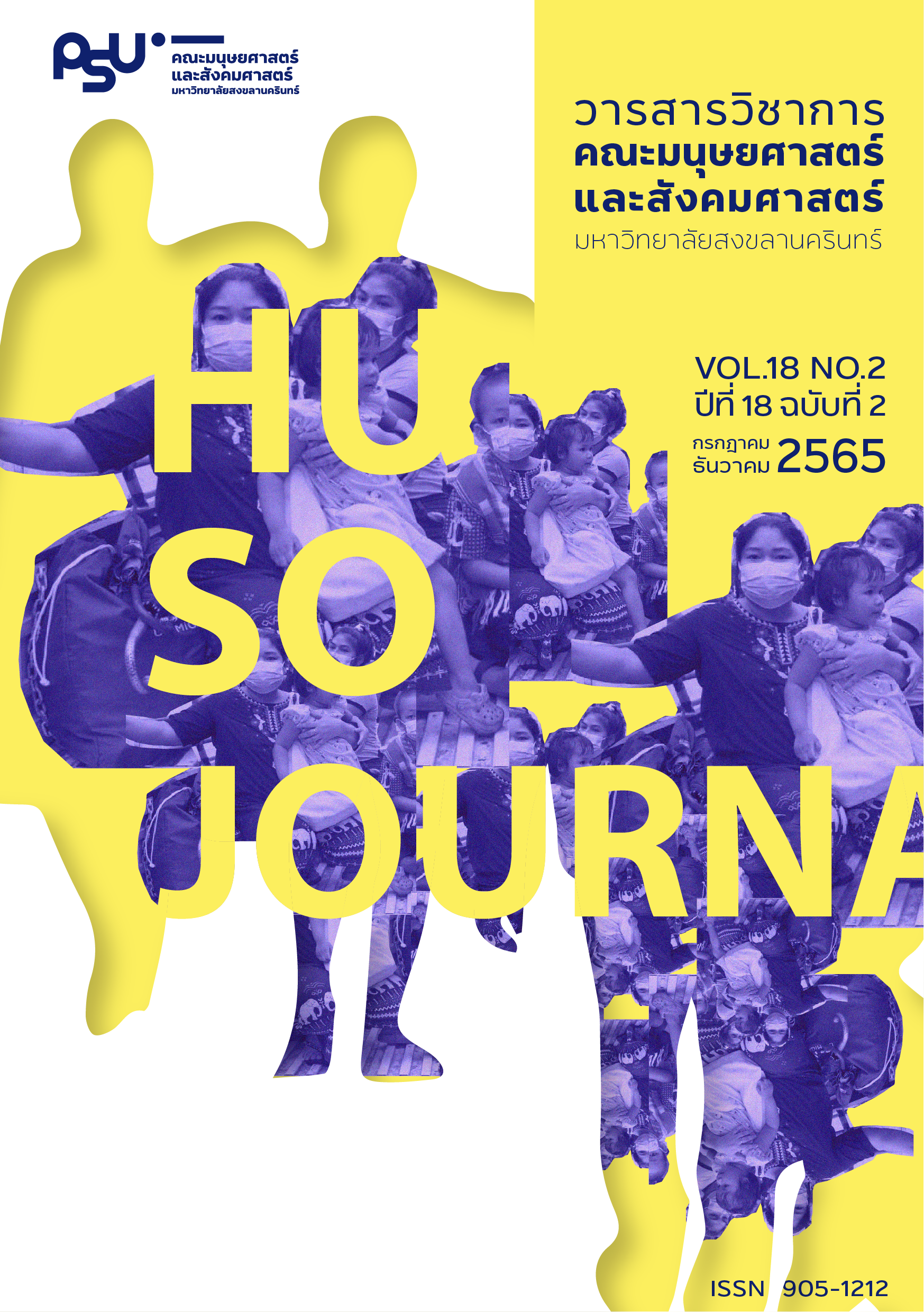A Study of Origin and Roles of Khanom Thien in Annual Rituals of Thai-Chinese People in the area of Muang district, Pattani province
Keywords:
Khanom Tien, Thai - Chinese people, Belief system; Offerings, Annual festivals, Pattani provinceAbstract
The research aimed 1) to study the history of Khanom Thien in Muang Pattani district, Pattani province, and 2) to study of roles and meanings of Khanom Thien in the annual rituals of Thai-Chinese people in Muang Pattani district, Pattani province. Gathering through documents, interviews, and participant Observation. Khanom Thien originated from some Chinese desserts such as Sticky bean bags, Bean buns and Banana leaves glutinous rice cake. Which has raw materials and cooking methods similar to Khanom Thien, but Chinese immigrants in Thailand applied to raw materials and cooking methods of local Thai people. Therefore, Khanom Thien is a culture object blending of Thai and Chinese cultural. The annual festivals which Khanom Tian is associated with offerings to goddesses and ancestors include 4 festivals namely 1) Chinese New Year 2) Qingming 3) Chinese Sart and 4) the tenth Lunar Month (Sat Duan Sip). Beliefs related to Khanom Thien of Thai - Chinese people and local Thai people are consistent. It is believed that Khanom Thien represents auspiciousness. Both raw materials convey the tenacity of the offspring. It's shaped like a pagoda or a name that looks like a bright candle. The descendants who pay homage to their ancestors with Khanom
Thien will receive good things in response.
References
เอกสารอ้างอิง
จักรกฤษณ์ เกษกาญจนานุช และ จตุวิทย์ แก้วสุวรรณ. (2563). กระบวนการกลายของขนมแบบฉบับแต้จิ๋วประจำเทศกาลจีนในสังคมไทย. วารสารอารยธรรมศึกษา โขง-สาละวิน ปีที่ 11, ฉบับที่ 2 กรกฎาคม - ธันวาคม 2563.
เจษฎา นิลสงวนเดชะ. (2562). มอง “สังคมชาวจีนภาคใต้ของไทย” ผ่านพระราชหัตถเลขาพระบาทสมเด็จพระจุลจอมเกล้าเจ้าอยู่หัวคราวเสด็จประพาสแหลมมลายู ร.ศ. 109, วารสารมนุษยศาสตร์และสังคมศาสตร์ ปีที่ 10 ฉบับที่ 1 มกราคม–มิถุนายน 2562.
ณัฐธิดา สุขมนัส. (2539). ความเชื่อเรื่องฮวงจุ้ยในวิถีชีวิตของชาวไทยเชื้อสายจีนในกรุงเทพมหานคร. (วิทยานิพนธ์ปริญญามหาบัณฑิต). จุฬาลงกรณ์มหาวิทยาลัย. บัณฑิตวิทยาลัย. ภาควิชาสังคมวิทยาและมานุษยวิทยา.
ถาวร สิกขโกศล. (2557). เทศกาลจีนและการเซ่นไหว้. กรุงเทพฯ: มติชนนารี เอี่ยมวิวัฒน์กิจ ชูเรืองสุข. (2555, กุมภาพันธ์ 6). ขนมเต้าเปาคือขนมเทียนกับรูปลักษณ์ใกล้เคียงขนมประเทศเพื่อนบ้าน. [เว็บบล็อค]. สืบค้นเมื่อ 5 กันยายน 2564 จาก https://www.gotoknow.org/posts/477828
นารี เอี่ยมวิวัฒน์กิจ ชูเรืองสุข. (2555, กุมภาพันธ์ 6). ขนมเต้าเปาคือขนมเทียนกับรูปลักษณ์ใกล้เคียงขนมประเทศเพื่อนบ้าน. [เว็บบล็อค]. สืบค้นเมื่อ 5 กันยายน 2564 จาก https://www.gotoknow.org/posts/477828
นารีรัตน์ วัฒนเวฬุ. (2561). วัฒนธรรมอาหารโต๊ะจีนในงานฉลองมงคลสมรสของชาวไทยเชื้อสายจีนในอำเภอเบตง จังหวัดยะลา. วารสารวิเทศศึกษา ปีที่ 8 ฉบับที่ 2 กรกฎาคม – ธันวาคม 2561.
บ้านสวนพอเพียง.(2553).ขนมเทียนเทียนแบบแบนที่พบในภาคใต้ของไทย [รูปภาพ].สืบค้นเมื่อ 17 กันยายน 2564 จาก http://www.bansuanporpeang.com/node/5232
ปรีชาชาญ แก้วนุ้ย. (2556). การผสมผสานทางวัฒนธรรมระหว่างไทยพุทธกับไทยมุสลิมในเขตจังหวัดภาคใต้ตอนล่าง. (วิทยานิพนธ์ปริญญามหาบัณฑิต). มหาวิทยาลัยสงขลานครินทร์. บัณฑิตวิทยาลัย. สาขาวิชารัฐประศาสนศาสตร์.
วิภานี กาญจนาภิญโญกุล. (2545). ขนมไทยและวัฒนธรรมการบริโภค : กรณีศึกษาตลาดดอนหวาย. (วิทยานิพนธ์ปริญญามหาบัณฑิต). มหาวิทยาลัยธรรมศาสตร์. คณะสังคมวิทยาและมานุษยวิทยา.
ศยามล เจริญรัตน์. (2544). “งิ้วแต้จิ๋ว” ในฐานะละครสังคม : สัญลักษณ์ทางชาติพันธุ์ไทยจีน. (วิทยานิพนธ์ปริญญามหาบัณฑิต). จุฬาลงกรณ์มหาวิทยาลัย. คณะรัฐศาสตร์. ภาควิชาสังคมวิทยาและมานุษยวิทยา.
สมพิศ วีระณะ. (2555). ตามรอยพระราชนิพนธ์ กาพย์เห่ชมเครื่องคาวหวาน พระบาทสมเด็จพระพุทธเลิศหล้านภาลัย. กรุงเทพฯ: วี.พริ้นท์ (1991).
สำนักข่าว กรมประชาสัมพันธ์ . (2563, กันยายน 2).ขนมเทียนของภาคใต้ทั้งแบบแบน และ แบบห่อเป็นรูปทรงสามเหลี่ยมพีระมิด [รูปภาพ].สืบค้นเมื่อ 5 กันยายน 2564 จาก https://nbtworld.prd.go.th/th/news/detail/TCATG200902101407378
Arshad M., Ishak F., Karim M., Kamaruzaman M. (2020). The diversity of traditional Malay kuih in Malaysia and its potentials. Journal of Ethnic Foods. December 2020: 7(1)
李永球 . (2014). 豆包仔粿. [Image]. Retrieved From http://ahkew.blogkaki.net/137067
DIY美食工坊.(2019). Kuih koci - 三角椰丝粿. [Image]. Retrieved From 搜抓:https://www.sohu.com/a/303596984_100216039
银行老王.(2018). 粘豆包. [Image]. 2021,October, 2 , Retrieved From Steemit: https://bit.ly/3psqrA9
厦门好料. (2021). 豆包粿. [Image]. 2021,October, 2 , Retrieved From 腾讯网: https://bit.ly/31wIUmO
阿轲.(2020).蕉叶糍.[Image]. 2021,October, 15 , Retrieved From 知乎: https://zhuanlan.zhihu.com/p/210313195
สัมภาษณ์
สัมภาษณ์คุณเศรษฐศักดิ์ อนุกูล, 5 ตุลาคม 2564.
สัมภาษณ์คุณสงวน มณีโชติ (คุณยายสิ้ม) , 6 ตุลาคม 2564.
สัมภาษณ์คุณอรพินท์, 10 ตุลาคม 2564.
สัมภาษณ์คุณผ่องพรรณ จันทร์อิสระ (คุณยายฉ้อง), 10 ตุลาคม 2564.
สัมภาษณ์คุณเสาวณีย์ รัตนะ, 10 ตุลาคม 2564.
สัมภาษณ์คุณสุพิพร มณีโชติ, 10 ตุลาคม 2564.
สัมภาษณ์คุณณี , 10 ตุลาคม 2564.
สัมภาษณ์คุณทิพวรรณ คงภักดี, 5 ตุลาคม 2564.
สัมภาษณ์คุณชัยยศ รองเดช, 11 ตุลาคม 2564.
สัมภาษณ์คุณชินพรรน์ เต่งศิริเตชากิตติ์, 11 ตุลาคม 2564.
สัมภาษณ์คุณวรรณดี ชาพรมสิทธิ์ 15 ตุลาคม 2564.
สัมภาษณ์คุณบี (นามสมมุติ) , 7 ตุลาคม 2564.
สัมภาษณ์คุณสมฤดี (นามสมมุติ) , 7 ตุลาคม 2564.
สัมภสัมภาษณ์คุณสมชาย (นามสมมุติ), 7 ตุลาคม 2564.
สัมสัมภาษณ์คุณสมเจตต์ (นามสมมุติ) , 5 ตุลาคม 2564
สัมภาษณ์คุณผึ้ง (นามสมมุติ), 5 ตุลาคม 2564.
สัมภาษณ์คุณโบว์ (นามสมมุติ), 5 ตุลาคม 2564.
สัมภาษณ์คุณอิง (นามสมมุติ) , 7 ตุลาคม 2564.
สัมภาษณ์คุณอิ่ม (นามสมมุติ) , 12 ตุลาคม 2564.
สัมภาษณ์คุณติ๋ม (นามสมมุติ) , 12 ตุลาคม 2564.
Downloads
Published
How to Cite
Issue
Section
License
Copyright (c) 2022 Journal of Humanities and Social Sciences Prince of Songkla University

This work is licensed under a Creative Commons Attribution-NonCommercial-NoDerivatives 4.0 International License.
บทความนี้ได้รับการตีพิมพ์เป็นของวารสารวิชาการคณะมนุษยศาสตร์และสังคมศาสตร์ คณะมนุษยศาสตร์และสังคมศาสตร์ มหาวิทยาลัยสงขลานครินทร์ วิทยาเขตปัตตานี






